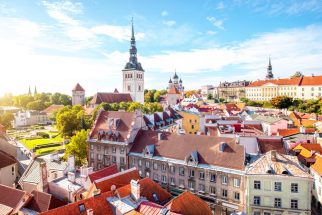Estonia is an unique destination in north of Europe. Even if, together with Latvia and Lithuania, it had been part of the Russian Empire since the 18th century, it has a marked ethnic and linguistic affinity with Finland.
Estonia is an amazing flat land characterized by small hills, numerous lakes, rivers, forests, islands, castles and picturesque small nordic towns. Discover the untouched nature, the peace and the culture of the most “scandinavian” country in the Baltics.
Popular destinations in Estonia are the capital Tallinn (the old town is listed as UNESCO World Heritage Site), Tartu, Pärnu, and the islands of Saaremaa, Hiumaa and Kihnu.
We recommend not to stick on visiting the capital city. In order to appreciate the essence of Estonia, its culture, the people and the nature feel free to choose one of the cities in the south of the country like Tartu, Viljandi or Võru. In the summer, we suggest to add the islands of Saaremaa and Hiumaa or the city of Pärnu to the trip.
May to late August is the best time to visit Estonia. Especially in June and July, the Baltic beaches and inland lakes are particularly popular for Estonians. Spring is ripe for bird watching with Steller’s eiders, long-tailed ducks, Bewick’s swans, and thousands of geese occupying the islands and shallow bays from Feb-April.
"Estonia - My Home | Inspired By Our Wonderful Nature", a mesmerizing visual journey captured by award-winning photographer and videomaker Priidu Saart from Saaremaa. Experience the enchanting transformation of Estonia's landscapes across all four seasons in this immersive celebration of the country's unique charm and natural beauty.
Top destinations in Estonia
The country of Estonia
| Capital | Tallinn |
| Time in Estonia |
UTC +02:00 (EET) Summer (DST) UTC +03:00 (EEST) |
| Language spoken | Estonian (official), Russian (56%) |
| Religion |
No religion (64.9%) Christians (34%) |
| Population | 1,331,796 (2022 estimate) |
| Currency | Euro |
Estonia is a democratic Unitary parliamentary republic (Estonian: Eesti Vabariik) member of the European Union since the 1st May of 2004. It is administratively subdivided into 15 maakond (counties)The capital and largest city is Tallinn, that hosts 430.000 people, followed by Tartu (93K), Narva (56K), Parnu (39K), Kohtla-Järve (34K), Viljandi (17K) and Rakvere (15K).
Where is Estonia located?
Located in northeastern Europe, Estonia juts out into the Baltic Sea, which surrounds the country to the north and west. To east Estonia is bounded by Russia—predominantly by the Narva River and Lakes Peipus (Peipsi; Russian: Chudskoye Ozero), Tyoploye, and Pskov—and to the south, it is bounded by Latvia. The Capital, Tallinn is two hours away by ferry from Helsinki, Finland.
Best time to visit Estonia
The warmest weather and longest daylight hours are in the summer months, although the tourism trade can be very busy in July with visiting holidaymakers from Scandinavia.
June and August are perfect months to visit Estonia. The winter months see only six hours of daylight and harsh temperatures. In the spring and autumn months, the weather is still pleasant and hotel prices tend to be lower.
Nature and wildlife
Estonia’s attention tonature is such that it is considered a privileged destination for those looking for holidays immersed in nature (within there are 5 national parks, 318 protected reserves, more than 1,520 islands, 340 species of birds, 60 mammals and countless possibilities to practice birdwatching, horse riding, rafting, canoeing, kayaking, sailing, hiking, golf and so on).
The islands of Estonia
Estonia has approximately 2.222 islands, located mainly on the north and west coast. Biggest islands are located north west: Saaremaa and Hiumaa, surrounded by Vormsi and Muhu. To be mentioned, the island of Kihnu (UNESCO world heritage site) and Ruhnu (the “pearl of the Gulf of Riga”), both located in the large bay between Latvia and Estonia.
Ornithological oases
There are also several ornithological oases including Matsalu, one of the largest migratory stations in Europe through which over 280 species pass that attract birdwatchers from all over the world, especially in the period of the so-called “great migration”.
Culture
Due to its history and geography, Estonia’s culture has been influenced by Finnic, Baltic, Slavic and Germanic peoples as well as the cultural developments in the former dominant powers Germany, Sweden and Russia.
Food & drink
Food in Estonia has a tendency towards the savory, with meat playing a major role in most meals. Black pudding is considered an Estonian national dish, and vegetarianism is almost unheard of. Desserts tend to be pastry-based. Estonians are big drinkers of black coffee, but serve it white for foreigners. The national alcoholic beverage is Vana Tallinn, a spiced liqueur, and beer is also renowed throughout the country.
Languages
Unlike Swedish, Latvian and Russian, Estonian is not an Indo-European language and belongs to the Finnish branch of the Uralic languages. Despite its different origins, the Estonian language has many similarities with the German one. Russian is the most widely spoken minority language. The most common foreign languages learned by Estonian students are English, Russian, German, and French. Other popular languages include Finnish, Spanish, and Swedish.
Recommendations:
- Take a spa weekend in Estonia
- Tour Lahemaa National Park
- Step back in history in the 13th century Narva Castle
- Sail around Estonia’s numerous islands
- Visit the 17th-century university in the city of Tartu

















